Analyzing Buddhism's Comprehensive Influence on Chinese Culture
VerifiedAdded on 2023/06/08
|6
|1554
|182
Essay
AI Summary
This essay examines the profound influence of Buddhism on Chinese culture, highlighting its integration with indigenous religions like Confucianism and Taoism. It discusses how Buddhist missionaries introduced principles of peace, compassion, and non-attachment, which gradually permeated Chinese society. The essay also explores the interchange of cultural elements between Buddhism and Taoism, the rise of Chinese Buddhist schools, and the impact on Chinese literature, architecture, and philosophical thought. It further elaborates on the political implications of Buddhist influence on the ruling class and concludes that Buddhism significantly shaped the religious culture of China, leading to the adoption of Buddhist teachings and rituals, and establishing Buddhism as one of the dominant religions in the country.
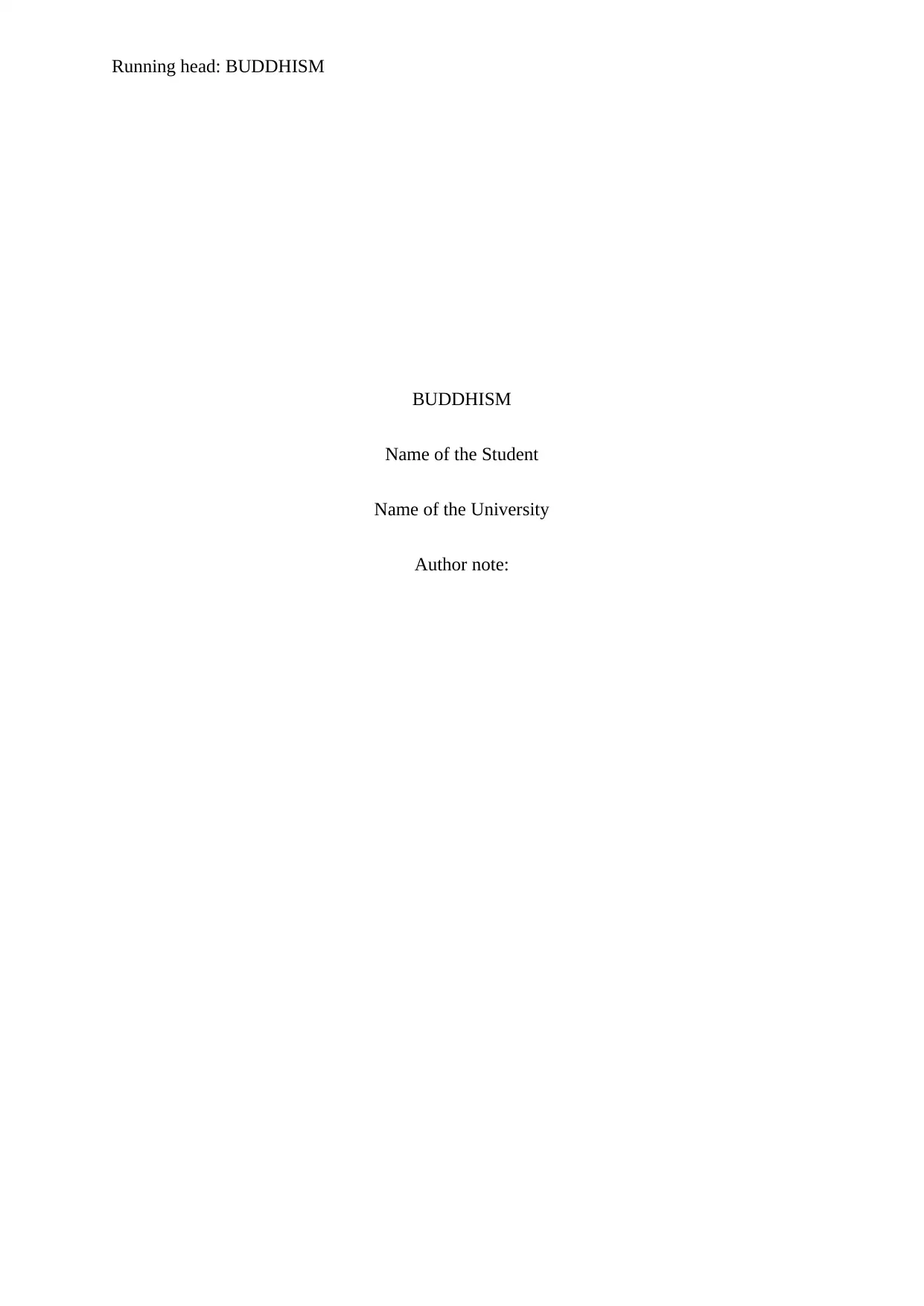
Running head: BUDDHISM
BUDDHISM
Name of the Student
Name of the University
Author note:
BUDDHISM
Name of the Student
Name of the University
Author note:
Secure Best Marks with AI Grader
Need help grading? Try our AI Grader for instant feedback on your assignments.
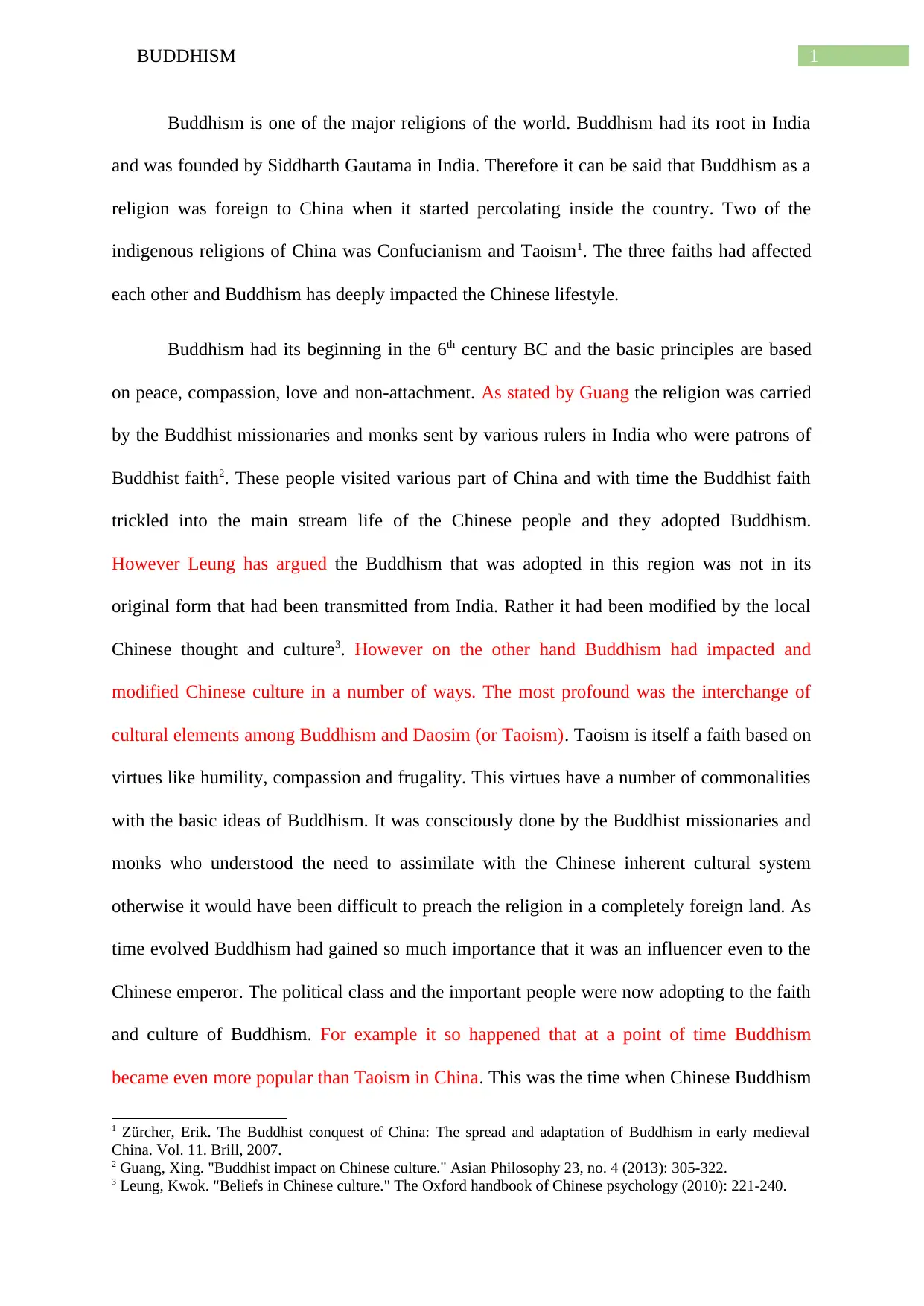
1BUDDHISM
Buddhism is one of the major religions of the world. Buddhism had its root in India
and was founded by Siddharth Gautama in India. Therefore it can be said that Buddhism as a
religion was foreign to China when it started percolating inside the country. Two of the
indigenous religions of China was Confucianism and Taoism1. The three faiths had affected
each other and Buddhism has deeply impacted the Chinese lifestyle.
Buddhism had its beginning in the 6th century BC and the basic principles are based
on peace, compassion, love and non-attachment. As stated by Guang the religion was carried
by the Buddhist missionaries and monks sent by various rulers in India who were patrons of
Buddhist faith2. These people visited various part of China and with time the Buddhist faith
trickled into the main stream life of the Chinese people and they adopted Buddhism.
However Leung has argued the Buddhism that was adopted in this region was not in its
original form that had been transmitted from India. Rather it had been modified by the local
Chinese thought and culture3. However on the other hand Buddhism had impacted and
modified Chinese culture in a number of ways. The most profound was the interchange of
cultural elements among Buddhism and Daosim (or Taoism). Taoism is itself a faith based on
virtues like humility, compassion and frugality. This virtues have a number of commonalities
with the basic ideas of Buddhism. It was consciously done by the Buddhist missionaries and
monks who understood the need to assimilate with the Chinese inherent cultural system
otherwise it would have been difficult to preach the religion in a completely foreign land. As
time evolved Buddhism had gained so much importance that it was an influencer even to the
Chinese emperor. The political class and the important people were now adopting to the faith
and culture of Buddhism. For example it so happened that at a point of time Buddhism
became even more popular than Taoism in China. This was the time when Chinese Buddhism
1 Zürcher, Erik. The Buddhist conquest of China: The spread and adaptation of Buddhism in early medieval
China. Vol. 11. Brill, 2007.
2 Guang, Xing. "Buddhist impact on Chinese culture." Asian Philosophy 23, no. 4 (2013): 305-322.
3 Leung, Kwok. "Beliefs in Chinese culture." The Oxford handbook of Chinese psychology (2010): 221-240.
Buddhism is one of the major religions of the world. Buddhism had its root in India
and was founded by Siddharth Gautama in India. Therefore it can be said that Buddhism as a
religion was foreign to China when it started percolating inside the country. Two of the
indigenous religions of China was Confucianism and Taoism1. The three faiths had affected
each other and Buddhism has deeply impacted the Chinese lifestyle.
Buddhism had its beginning in the 6th century BC and the basic principles are based
on peace, compassion, love and non-attachment. As stated by Guang the religion was carried
by the Buddhist missionaries and monks sent by various rulers in India who were patrons of
Buddhist faith2. These people visited various part of China and with time the Buddhist faith
trickled into the main stream life of the Chinese people and they adopted Buddhism.
However Leung has argued the Buddhism that was adopted in this region was not in its
original form that had been transmitted from India. Rather it had been modified by the local
Chinese thought and culture3. However on the other hand Buddhism had impacted and
modified Chinese culture in a number of ways. The most profound was the interchange of
cultural elements among Buddhism and Daosim (or Taoism). Taoism is itself a faith based on
virtues like humility, compassion and frugality. This virtues have a number of commonalities
with the basic ideas of Buddhism. It was consciously done by the Buddhist missionaries and
monks who understood the need to assimilate with the Chinese inherent cultural system
otherwise it would have been difficult to preach the religion in a completely foreign land. As
time evolved Buddhism had gained so much importance that it was an influencer even to the
Chinese emperor. The political class and the important people were now adopting to the faith
and culture of Buddhism. For example it so happened that at a point of time Buddhism
became even more popular than Taoism in China. This was the time when Chinese Buddhism
1 Zürcher, Erik. The Buddhist conquest of China: The spread and adaptation of Buddhism in early medieval
China. Vol. 11. Brill, 2007.
2 Guang, Xing. "Buddhist impact on Chinese culture." Asian Philosophy 23, no. 4 (2013): 305-322.
3 Leung, Kwok. "Beliefs in Chinese culture." The Oxford handbook of Chinese psychology (2010): 221-240.
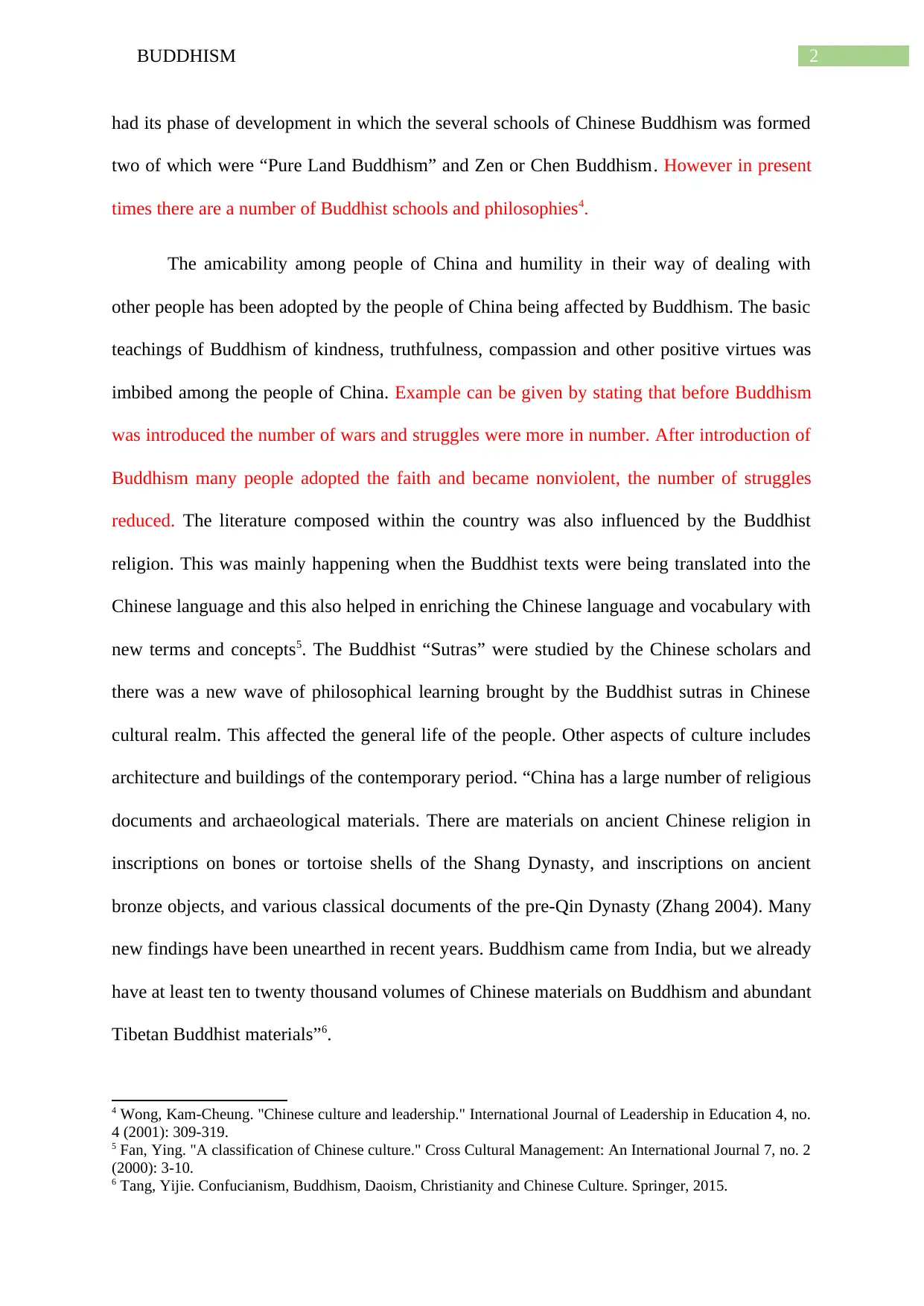
2BUDDHISM
had its phase of development in which the several schools of Chinese Buddhism was formed
two of which were “Pure Land Buddhism” and Zen or Chen Buddhism. However in present
times there are a number of Buddhist schools and philosophies4.
The amicability among people of China and humility in their way of dealing with
other people has been adopted by the people of China being affected by Buddhism. The basic
teachings of Buddhism of kindness, truthfulness, compassion and other positive virtues was
imbibed among the people of China. Example can be given by stating that before Buddhism
was introduced the number of wars and struggles were more in number. After introduction of
Buddhism many people adopted the faith and became nonviolent, the number of struggles
reduced. The literature composed within the country was also influenced by the Buddhist
religion. This was mainly happening when the Buddhist texts were being translated into the
Chinese language and this also helped in enriching the Chinese language and vocabulary with
new terms and concepts5. The Buddhist “Sutras” were studied by the Chinese scholars and
there was a new wave of philosophical learning brought by the Buddhist sutras in Chinese
cultural realm. This affected the general life of the people. Other aspects of culture includes
architecture and buildings of the contemporary period. “China has a large number of religious
documents and archaeological materials. There are materials on ancient Chinese religion in
inscriptions on bones or tortoise shells of the Shang Dynasty, and inscriptions on ancient
bronze objects, and various classical documents of the pre-Qin Dynasty (Zhang 2004). Many
new findings have been unearthed in recent years. Buddhism came from India, but we already
have at least ten to twenty thousand volumes of Chinese materials on Buddhism and abundant
Tibetan Buddhist materials”6.
4 Wong, Kam-Cheung. "Chinese culture and leadership." International Journal of Leadership in Education 4, no.
4 (2001): 309-319.
5 Fan, Ying. "A classification of Chinese culture." Cross Cultural Management: An International Journal 7, no. 2
(2000): 3-10.
6 Tang, Yijie. Confucianism, Buddhism, Daoism, Christianity and Chinese Culture. Springer, 2015.
had its phase of development in which the several schools of Chinese Buddhism was formed
two of which were “Pure Land Buddhism” and Zen or Chen Buddhism. However in present
times there are a number of Buddhist schools and philosophies4.
The amicability among people of China and humility in their way of dealing with
other people has been adopted by the people of China being affected by Buddhism. The basic
teachings of Buddhism of kindness, truthfulness, compassion and other positive virtues was
imbibed among the people of China. Example can be given by stating that before Buddhism
was introduced the number of wars and struggles were more in number. After introduction of
Buddhism many people adopted the faith and became nonviolent, the number of struggles
reduced. The literature composed within the country was also influenced by the Buddhist
religion. This was mainly happening when the Buddhist texts were being translated into the
Chinese language and this also helped in enriching the Chinese language and vocabulary with
new terms and concepts5. The Buddhist “Sutras” were studied by the Chinese scholars and
there was a new wave of philosophical learning brought by the Buddhist sutras in Chinese
cultural realm. This affected the general life of the people. Other aspects of culture includes
architecture and buildings of the contemporary period. “China has a large number of religious
documents and archaeological materials. There are materials on ancient Chinese religion in
inscriptions on bones or tortoise shells of the Shang Dynasty, and inscriptions on ancient
bronze objects, and various classical documents of the pre-Qin Dynasty (Zhang 2004). Many
new findings have been unearthed in recent years. Buddhism came from India, but we already
have at least ten to twenty thousand volumes of Chinese materials on Buddhism and abundant
Tibetan Buddhist materials”6.
4 Wong, Kam-Cheung. "Chinese culture and leadership." International Journal of Leadership in Education 4, no.
4 (2001): 309-319.
5 Fan, Ying. "A classification of Chinese culture." Cross Cultural Management: An International Journal 7, no. 2
(2000): 3-10.
6 Tang, Yijie. Confucianism, Buddhism, Daoism, Christianity and Chinese Culture. Springer, 2015.
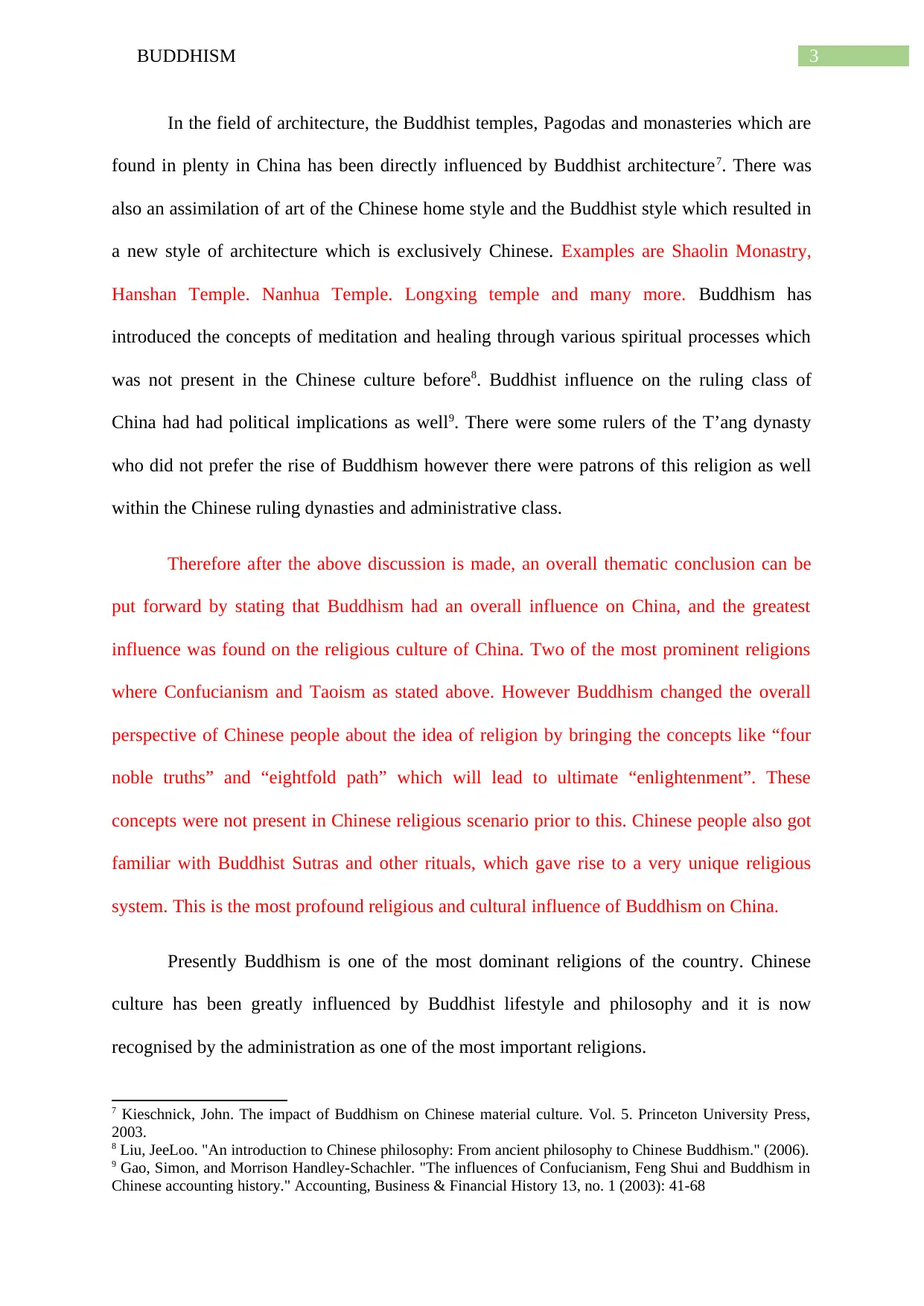
3BUDDHISM
In the field of architecture, the Buddhist temples, Pagodas and monasteries which are
found in plenty in China has been directly influenced by Buddhist architecture7. There was
also an assimilation of art of the Chinese home style and the Buddhist style which resulted in
a new style of architecture which is exclusively Chinese. Examples are Shaolin Monastry,
Hanshan Temple. Nanhua Temple. Longxing temple and many more. Buddhism has
introduced the concepts of meditation and healing through various spiritual processes which
was not present in the Chinese culture before8. Buddhist influence on the ruling class of
China had had political implications as well9. There were some rulers of the T’ang dynasty
who did not prefer the rise of Buddhism however there were patrons of this religion as well
within the Chinese ruling dynasties and administrative class.
Therefore after the above discussion is made, an overall thematic conclusion can be
put forward by stating that Buddhism had an overall influence on China, and the greatest
influence was found on the religious culture of China. Two of the most prominent religions
where Confucianism and Taoism as stated above. However Buddhism changed the overall
perspective of Chinese people about the idea of religion by bringing the concepts like “four
noble truths” and “eightfold path” which will lead to ultimate “enlightenment”. These
concepts were not present in Chinese religious scenario prior to this. Chinese people also got
familiar with Buddhist Sutras and other rituals, which gave rise to a very unique religious
system. This is the most profound religious and cultural influence of Buddhism on China.
Presently Buddhism is one of the most dominant religions of the country. Chinese
culture has been greatly influenced by Buddhist lifestyle and philosophy and it is now
recognised by the administration as one of the most important religions.
7 Kieschnick, John. The impact of Buddhism on Chinese material culture. Vol. 5. Princeton University Press,
2003.
8 Liu, JeeLoo. "An introduction to Chinese philosophy: From ancient philosophy to Chinese Buddhism." (2006).
9 Gao, Simon, and Morrison Handley-Schachler. "The influences of Confucianism, Feng Shui and Buddhism in
Chinese accounting history." Accounting, Business & Financial History 13, no. 1 (2003): 41-68
In the field of architecture, the Buddhist temples, Pagodas and monasteries which are
found in plenty in China has been directly influenced by Buddhist architecture7. There was
also an assimilation of art of the Chinese home style and the Buddhist style which resulted in
a new style of architecture which is exclusively Chinese. Examples are Shaolin Monastry,
Hanshan Temple. Nanhua Temple. Longxing temple and many more. Buddhism has
introduced the concepts of meditation and healing through various spiritual processes which
was not present in the Chinese culture before8. Buddhist influence on the ruling class of
China had had political implications as well9. There were some rulers of the T’ang dynasty
who did not prefer the rise of Buddhism however there were patrons of this religion as well
within the Chinese ruling dynasties and administrative class.
Therefore after the above discussion is made, an overall thematic conclusion can be
put forward by stating that Buddhism had an overall influence on China, and the greatest
influence was found on the religious culture of China. Two of the most prominent religions
where Confucianism and Taoism as stated above. However Buddhism changed the overall
perspective of Chinese people about the idea of religion by bringing the concepts like “four
noble truths” and “eightfold path” which will lead to ultimate “enlightenment”. These
concepts were not present in Chinese religious scenario prior to this. Chinese people also got
familiar with Buddhist Sutras and other rituals, which gave rise to a very unique religious
system. This is the most profound religious and cultural influence of Buddhism on China.
Presently Buddhism is one of the most dominant religions of the country. Chinese
culture has been greatly influenced by Buddhist lifestyle and philosophy and it is now
recognised by the administration as one of the most important religions.
7 Kieschnick, John. The impact of Buddhism on Chinese material culture. Vol. 5. Princeton University Press,
2003.
8 Liu, JeeLoo. "An introduction to Chinese philosophy: From ancient philosophy to Chinese Buddhism." (2006).
9 Gao, Simon, and Morrison Handley-Schachler. "The influences of Confucianism, Feng Shui and Buddhism in
Chinese accounting history." Accounting, Business & Financial History 13, no. 1 (2003): 41-68
Secure Best Marks with AI Grader
Need help grading? Try our AI Grader for instant feedback on your assignments.

4BUDDHISM
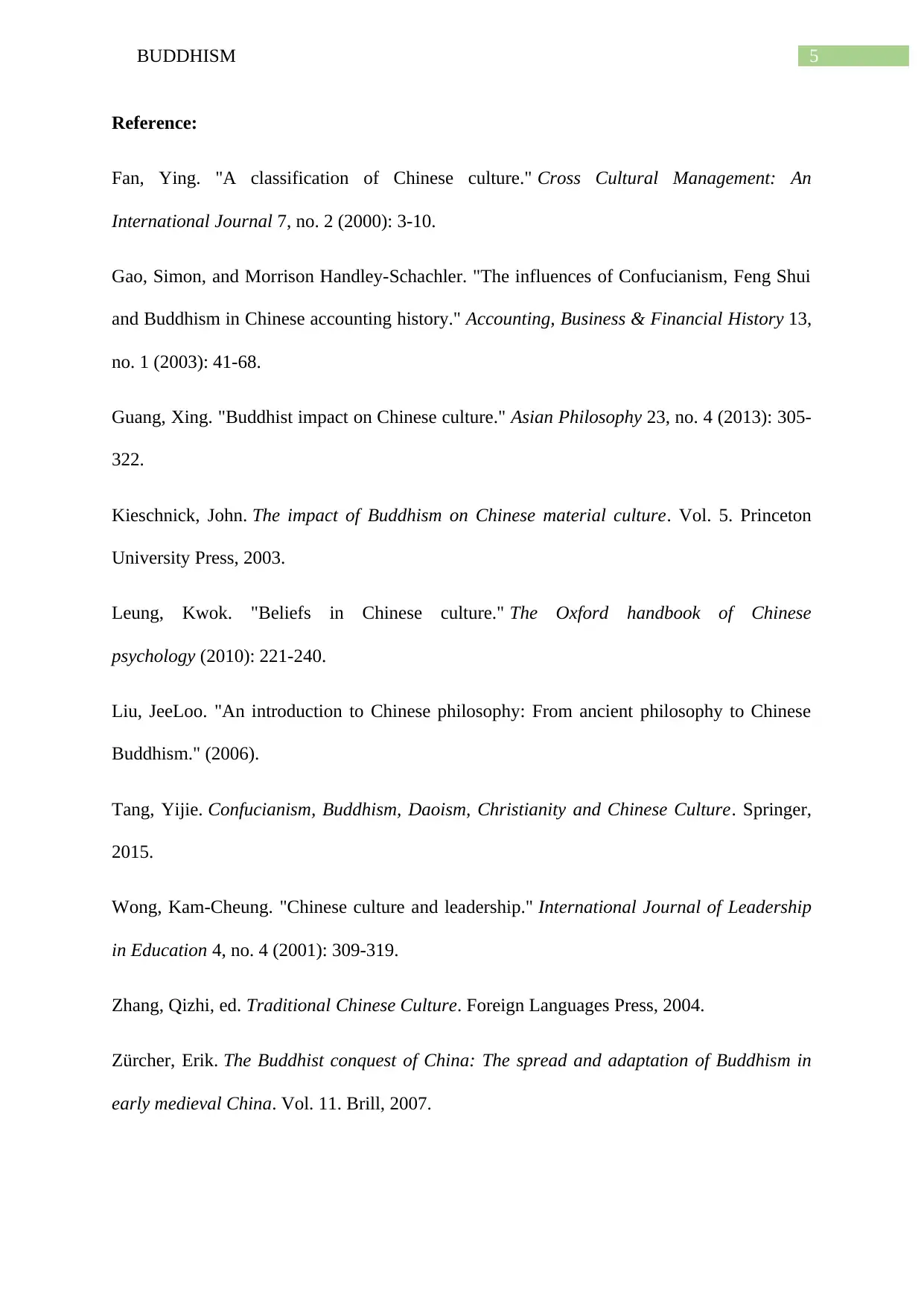
5BUDDHISM
Reference:
Fan, Ying. "A classification of Chinese culture." Cross Cultural Management: An
International Journal 7, no. 2 (2000): 3-10.
Gao, Simon, and Morrison Handley-Schachler. "The influences of Confucianism, Feng Shui
and Buddhism in Chinese accounting history." Accounting, Business & Financial History 13,
no. 1 (2003): 41-68.
Guang, Xing. "Buddhist impact on Chinese culture." Asian Philosophy 23, no. 4 (2013): 305-
322.
Kieschnick, John. The impact of Buddhism on Chinese material culture. Vol. 5. Princeton
University Press, 2003.
Leung, Kwok. "Beliefs in Chinese culture." The Oxford handbook of Chinese
psychology (2010): 221-240.
Liu, JeeLoo. "An introduction to Chinese philosophy: From ancient philosophy to Chinese
Buddhism." (2006).
Tang, Yijie. Confucianism, Buddhism, Daoism, Christianity and Chinese Culture. Springer,
2015.
Wong, Kam-Cheung. "Chinese culture and leadership." International Journal of Leadership
in Education 4, no. 4 (2001): 309-319.
Zhang, Qizhi, ed. Traditional Chinese Culture. Foreign Languages Press, 2004.
Zürcher, Erik. The Buddhist conquest of China: The spread and adaptation of Buddhism in
early medieval China. Vol. 11. Brill, 2007.
Reference:
Fan, Ying. "A classification of Chinese culture." Cross Cultural Management: An
International Journal 7, no. 2 (2000): 3-10.
Gao, Simon, and Morrison Handley-Schachler. "The influences of Confucianism, Feng Shui
and Buddhism in Chinese accounting history." Accounting, Business & Financial History 13,
no. 1 (2003): 41-68.
Guang, Xing. "Buddhist impact on Chinese culture." Asian Philosophy 23, no. 4 (2013): 305-
322.
Kieschnick, John. The impact of Buddhism on Chinese material culture. Vol. 5. Princeton
University Press, 2003.
Leung, Kwok. "Beliefs in Chinese culture." The Oxford handbook of Chinese
psychology (2010): 221-240.
Liu, JeeLoo. "An introduction to Chinese philosophy: From ancient philosophy to Chinese
Buddhism." (2006).
Tang, Yijie. Confucianism, Buddhism, Daoism, Christianity and Chinese Culture. Springer,
2015.
Wong, Kam-Cheung. "Chinese culture and leadership." International Journal of Leadership
in Education 4, no. 4 (2001): 309-319.
Zhang, Qizhi, ed. Traditional Chinese Culture. Foreign Languages Press, 2004.
Zürcher, Erik. The Buddhist conquest of China: The spread and adaptation of Buddhism in
early medieval China. Vol. 11. Brill, 2007.
1 out of 6
Your All-in-One AI-Powered Toolkit for Academic Success.
+13062052269
info@desklib.com
Available 24*7 on WhatsApp / Email
![[object Object]](/_next/static/media/star-bottom.7253800d.svg)
Unlock your academic potential
© 2024 | Zucol Services PVT LTD | All rights reserved.


